-
Celebrating 125 Years of The New York Public Library
Since its founding in 1895, The New York Public Library has been a source of inspiration and strength for all. With 92 locations across the Bronx, Manhattan, and Staten Island, NYPL is an essential resource for communities across New York City, as well as for users from around the world. Here's a look back at some of the Library's important moments.
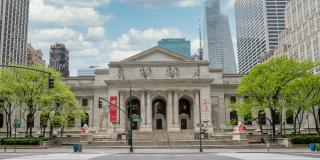
May 23, 1895
The resources of the Astor and Lenox libraries and the Tilden Trust are combined to form a new entity, to be known as The New York Public Library, Astor, Lenox and Tilden Foundations. The plan, signed and agreed upon on May 23, 1895, was hailed as an unprecedented example of private philanthropy for the public good.
Library Design Competition
After the foundation of The New York Public Library, one of the earliest projects of the Library Trustees was an architectural competition to find a design for a central branch at 42nd Street and Fifth Avenue on the site of the Croton Reservoir. Carrère & Hastings won the bid.

1901
Philanthropist Andrew Carnegie donates $5.2 million (the equivalent to $160 million today) to purchase land and build branch libraries that formed the backbone of The New York Public Library's circulating system. In an 1889 essay, Carnegie wrote that a free public library was the "best gift that can be given to a community."
The Early Days of Libraries in New York City
Ottendorfer Library opened in 1884 as New York City's first free public library. The branch became part of the New York Free Circulating Library, a system that consolidated with The New York Public Library in 1901. Now a designated New York City landmark, the branch continues to reflect its community and remains a vital educational and cultural resource for the East Village.

1907
St. George Library Center, the largest library on Staten Island, is built. The branch was designed by Carrère & Hastings, who designed the central location and were later commissioned by Andrew Carnegie to design 14 additional branches, including St. George Library Center, which together became known as “Carnegie libraries.”
Opening Day at the 42nd Street Library
The majestic Beaux-Arts building at Fifth Avenue and 42nd Street in Manhattan—featuring the world-renowned pair of marble lions, now known as Patience and Fortitude—opened to much fanfare on May 23, 1911, exactly sixteen years after the Library’s initial founding. The opening day ceremony was presided over by President William Howard Taft.

1911
The flagship building at Fifth Avenue and 42nd Street opens on the former site of the Croton Reservoir and was famous for being the largest marble building in the U.S. at the time.
Women's Rights
Because of its central location—and perhaps because of the Library’s role as a symbol of a free society—the 42nd Street library has often been the center stage of key historical moments throughout the 20th century.
Seen here, women marched for the right to vote in a suffrage parade in May 1913 on Fifth Avenue, as viewed from a stand in front of the 42nd Street library.

World War I
In 1916, NYPL hosted a book drive on the plaza of the 42nd Street library for soldiers. The 42nd Street library was the backdrop of many World War I activities, including patriotic theater, Liberty Bond rallies, parades, and events for soldiers like this book drive.
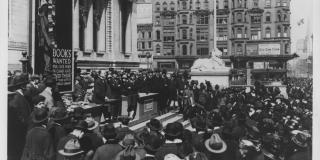
1925
The Division of Negro Literature, History and Prints—the forerunner to today’s Schomburg Center—opens as a special collection of the 135th Street Library in Harlem to meet the needs of a changing community.
The Division of Negro Literature, History and Prints
Soon after the Division of Negro Literature, History and Prints opened, the personal collection of the distinguished Black scholar and bibliophile, Arturo Alfonso Schomburg, was added, creating the foundation for what would become one of the world’s most important resources promoting the study of the history and culture of people of African descent.
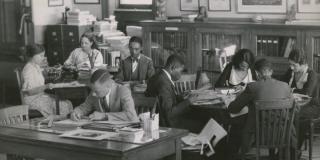
1929
The winter following the stock market crash of 1929 was the most active period in the Library’s history. It was not uncommon for there to be 800 to 1,000 people in the Main Reading Room at a time, a standing room only capacity.
The Great Depression
During the Great Depression, New York City Mayor Fiorello La Guardia dubbed the lions outside of the 42nd Street library “Patience” and “Fortitude”, qualities he felt New Yorkers needed to get by. They’ve been known by those names ever since, and continue to remain steadfast symbols of all the Library represents.
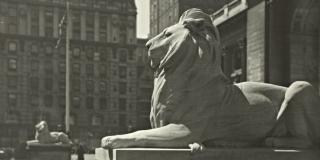
1941
On January 30, 1941, the Victory Book Campaign was launched on the steps of the 42nd Street library. This nationwide campaign encouraged the public to donate books for people serving in the armed forces and to supplement the Army and Navy's library service.
1941
During World War II, 12,000 items from the Library’s collection were temporarily moved to an undisclosed location.
Bookmobiles in the 1950s and Beyond
For decades, The New York Public Library has made efforts to extend its reach into the communities it serves. Seen here, kids lined up in front of NYPL’s Bronx Traveling Library in the 1950s. Today, the Library continues to be a driving force for reading with brand new Bookmobiles rolled out in 2019.

1961
Breakfast at Tiffany's becomes the first major film to feature the 42nd Street library. Since then, the building has become a popular set for movies including Ghostbusters, The Day After Tomorrow, and Sex and the City.
1963
Betty Friedan’s The Feminine Mystique, widely credited for sparking the beginning of second-wave feminism, is published—one of the many boundary-pushing works researched and written using The New York Public Library’s collections.
1965
The main branch at Fifth Avenue and 42nd Street is declared a National Historic Landmark. The building was later declared a New York City landmark in 1967.
1965
The New York Public Library for the Performing Arts opens. The Library for the Performing Arts houses one of the world's most extensive combinations of circulating, reference, and rare archival collections in its field.
The New York Public Library for the Performing Arts
An essential resource for everyone with an interest in the arts—whether professional or amateur—the Library is known particularly for its prodigious collections of non-book materials such as historic recordings, videotapes, autograph manuscripts, correspondence, sheet music, stage designs, press clippings, programs, posters, and photographs.

1970
Mid-Manhattan Library opens in the former Arnold Constable & Company department store located on Fifth Avenue and 40th Street, replacing the circulating library that was originally housed in the 42nd Street library.
1970
The inaugural celebration of Earth Day takes place on the steps of the 42nd Street library.
Earth Day
On April 22, 1970, Earth Day demonstrations took place around New York City. The 42nd Street library was the backdrop for speakers including NYC Mayor John Lindsay, Kurt Vonnegut, Roger Caras, Marya Mannes, Alfred Kazin, and others.
Pictured here from NYPL's Manuscripts and Archives Division: A poster for the first-ever Earth Day celebration alongside a schedule of events at the 42nd Street library.
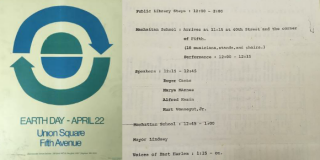
1972
The Schomburg Collection of Negro Literature, History and Prints is designated a research center of The New York Public Library and becomes the Schomburg Center for Research in Black Culture, featuring diverse programming and collections spanning over 11 million items that illuminate the richness of global Black history, arts, and culture.
Schomburg Center for Research in Black Culture
The Schomburg Center for Research in Black Culture in Harlem is one of the world’s leading cultural institutions devoted to the research, preservation, and exhibition of materials focused on African American, African Diaspora, and African experiences.
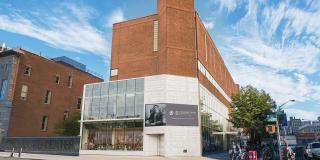
1987
Winnie-the-Pooh & Friends officially move to the Library. Every year, thousands of people come to see these beloved childhood toys.
Winnie-the-Pooh & Friends
Since 1987, Pooh and four of his best friends—Eeyore, Piglet, Kanga, and Tigger—have been living at The New York Public Library. Pooh and his friends are as happy as when they lived in the Hundred Acre Wood. They even received some special TLC in 2016—just in time for Pooh’s 95th birthday—to ensure future generations can continue to enjoy these special toys.

1991
The first level of the Library’s Milstein Research Stacks—the two-level underground storage facility below Bryant Park—opens, with the second level opening in 2015. Beginning in 1988, the ground was excavated 30 feet deep for the new 120,000 square-foot storage space.
1991
The Andrew Heiskell Braille and Talking Book Library opens its doors in the building on West 20th Street it occupies to this day. In addition to being an integral part of The New York Public Library—its collections being part of the NYPL system since 1901—the facility is a regional library in the Library of Congress National Library Service for the Blind and Physically Handicapped network.
1995
The Science, Industry and Business Library (SIBL) opens in the former B. Altman & Company Building on 34th Street and Madison Avenue. The premier public business library featured electronic resources, comprehensive print materials, and services for start-ups and established businesses seeking expansion, and for job seekers from entry to executive levels—all of which will be available at the Library’s upcoming Stavros Niarchos Foundation Library when it opens.
1999
The Cullman Center for Scholars and Writers is established in the 42nd Street Library as NYPL’s premier fellowship program. Since then, it has welcomed hundreds of accomplished creators from around the world as they make new work through the use of the Library’s vast collections.
2000
The New York Public Library signs a partnership agreement with Princeton University and Columbia University called the Research Collections and Preservation Consortium (ReCAP), providing researchers with access to materials from all three institutions. In 2019, Harvard University became a full member of the consortium.
2006
Bronx Library Center opens, replacing the Fordham Library, which previously served the Bronx. This location is now the largest public library in the Bronx.
Green Library
When it opened, Bronx Library Center earned LEED Silver certification, becoming The New York Public Library's first "green" library.

2011
The Stephen A. Schwarzman Building celebrates a century of serving New York City with a full façade renovation and a major exhibition called "Celebrating 100 Years."
2013
The brand new Mariners Harbor Library opens. The single-story branch library is located amidst the rich maritime heritage of Staten Island's Mariners Harbor neighborhood.
Mariners Harbor
Mariners Harbor is the 13th branch of The New York Public Library on Staten Island and serves roughly 30,000 people.

2013
BookOps, a shared library technical services organization, is created to serve both The New York Public Library and Brooklyn Public Library. BookOps is located in the Library Services Center in Long Island City—a state-of-the-art facility that, in addition to serving the strategic collection management and distribution needs of the two organizations, performs NYPL’s preservation and digital imaging services.
2016
The New York Public Library releases SimplyE, a free, open source e-reader app that brings together the Library’s entire collection of more than 300,000 e-books and audiobooks and makes them accessible all in one place.
SimplyE
SimplyE brings the Library to you—wherever you are. With our app, you can apply for a digital library card and start reading right away.

Libraries Are for Everyone
The New York Public Library was front and center at the Stephen A. Schwarzman Building during NYC’s World Pride celebration in June 2019—as well as in our branches all year long—and continues to remain a beacon of knowledge and opportunity for all.

2020
The New York Public Library honors its 125th year with the complete renovation and upcoming reopening of the Stavros Niarchos Foundation Library, the system's largest circulating branch.
125 Years of The New York Public Library
The Library turns 125 during an unprecedented moment for both New York City and the world. Despite the current challenges, our lions, Patience and Fortitude, remain a steadfast symbol for all that The New York Public Library represents: a source of inspiration and strength for all.
